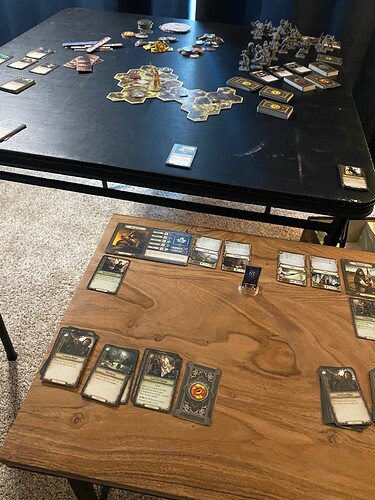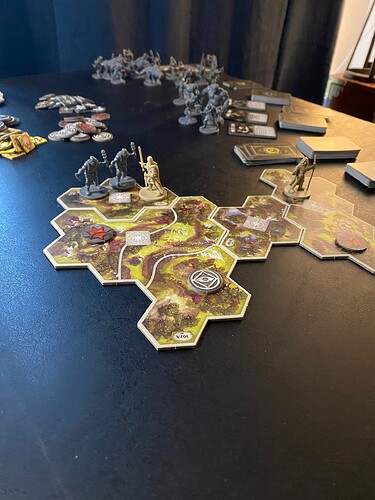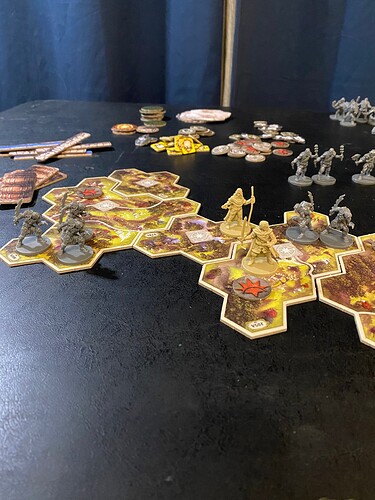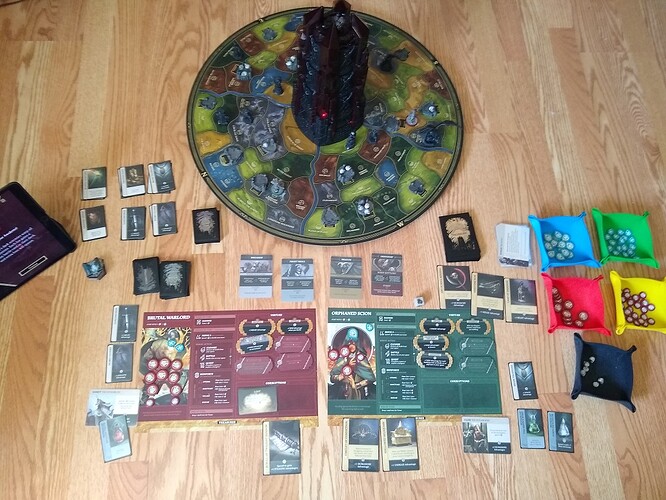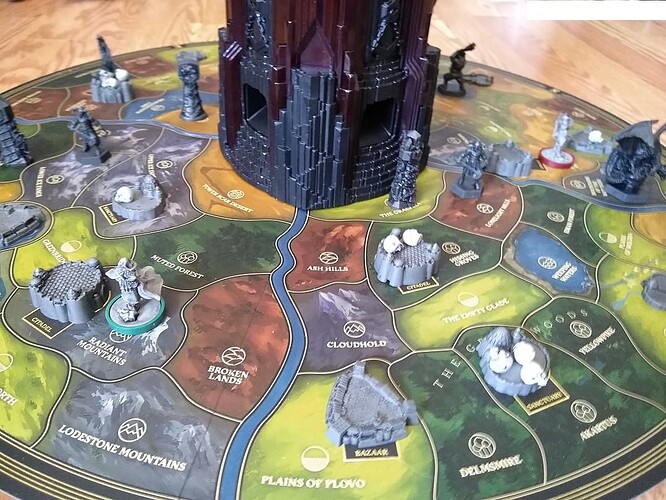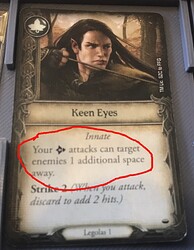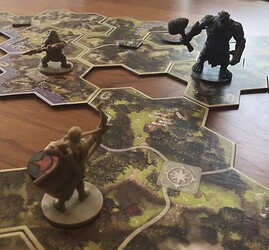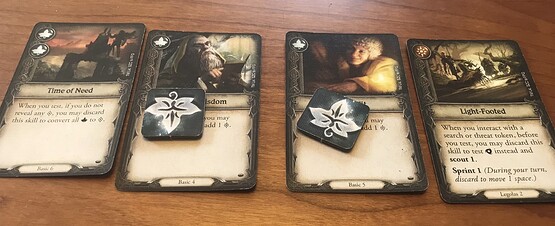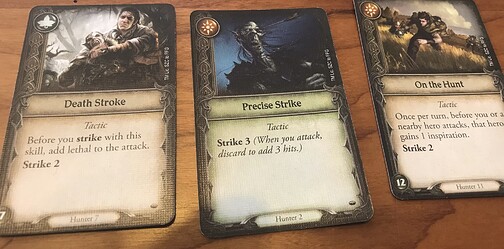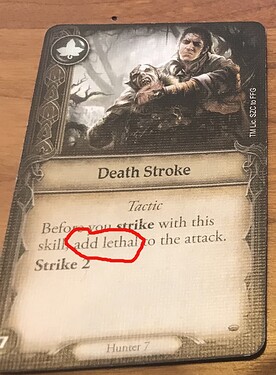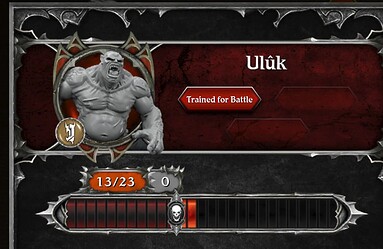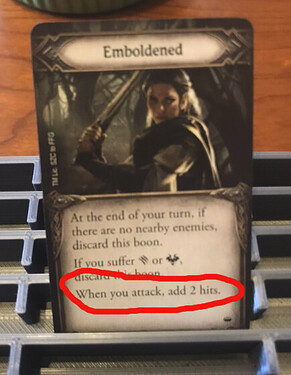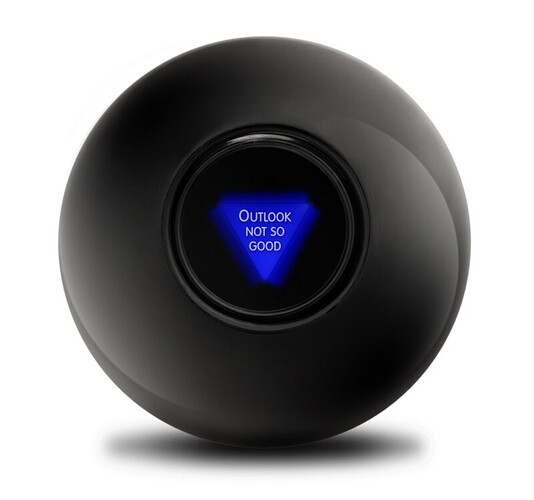Yeah, Journeys is all the small cards for items, damage, events, etc…and then Tarot-sized cards for characters.
I chose it in this very forum as my top boardgame of the past five years. In that post I said I particularly love the card draw mechanic that allows you to tweak your deck during the rally phase – that’s a reference to scouting. Such a tough decision if your scouting brings you a success card that also has a great ability. Prepare the card to use the ability, or put the card on top of your deck to guarantee a success in the next test? It’s tempting to do the latter, even though I know the former is usually the better choice in the long run.
I also love the test mechanic itself, drawing x number of cards based on a type of skill, and then applying inspiration tokens, modifiers, or skills. The fear and slash cards that are harmful have this face-up-or-face-down thing that takes some getting used to, but it has grown on me. I like the medium weight of the game, and of course the IP. I haven’t bought any expansions but may do so.
I do feel that normal difficulty is a bit too brutal, and adventure (baby) mode is too easy. I just need to get better and stay on normal. Can’t imagine playing on hard. I needed to wrap my head around the fact that adventuring is truly the goal, it is not merely a hack-n-slash. If you spend all your time killing baddies, you may run out of time, so running away is sometimes a better option. In fact some players think the Sprint ability is the most important.
This BGG strategy post linked below has been helpful to my approach to the game. He stresses preparing success cards, but then using them as fast as possible so they’ll cycle back in to your deck. I tend to use those better card abilities sparingly, so they stay prepared for several turns – not good.
He also believes the Scout ability is even more important than Sprint. “Scout allows you to play the game and stops the game playing you.”
I started up the app and away I went. The setup seemed straightforward until I hit something about adding Inspiration. I looked it up and found the token but do I automatically get one for each of my two characters (Aragorn and Beravor)? Well, I did.
Here is my initial setup based on what the app showed me.
On my first turn B moved southeast and uncovered two investigation tokens giving her two more inspiration tokens. Nice but not too exciting.
A moved up towards where some dudes where skulking, hid, overheard some general naughtiness, and was then heard himself (crows man, always squawking). So now I’m at my first fight. And…time to do some reading and figure it out.
Fiiiiggghhhtttt!
And, there ya go. I basically clicked thru the app and setup stuff as it said. But you also need to read they the booklet to setup your character as well. It’s not difficult but it’s not a tutorial either. And I expected more tutorial/guide/handholding than I received. I’ll have to go back thru but I don’t think the inspiration thing was mentioned at all. I had to look it up in the glossary. Once there, it made sense what to do and how it worked (I think) but it could have been presented better either in the app or the booklet.
The inspiration thing is a major part of the game, I can’t imagine it isn’t in the Learn to Play book.
Also, keep in mind that the tile layout is procedurally generated, so it can change on different plays even if the storyline is the same.
EDIT: See page 10 of Learn to Play, “Fate and Inspiration.”
Ya. Inspiration just sort of pops up right at the beginning of the app. But I didn’t see anything in the booklet about it when setting up characters. It seemed pretty important once I read up on it so it’s got to be somewhere that I missed. The rules aren’t huge so I’ll prob read them again only actually read them not so much skim.
EDIT:
Ok, see. The app drops the Inspiration thing before it goes into the turn proper. It was still in the setup phase it felt like, so I was sort of bouncing back and forth between the app and the LtoP booklet. And in the booklet never got to the part about Inspiration. Like I said, it’s not long so I’ll go thru it now and I can see it’s laid out a bit more tutorial like. Nice.
EDIT part Deuce:
LtoP booklet is setup like a mini-tutorial, followed by another more robust tutorial. Odd, but once you realize that it’s pretty good.
My Aragorn must be defective because I don’t think I pulled any successes on tests til maybe the 3rd or 4th turn. By then he was staggering around with 4 (of 5) wounds and a couple of Fear tossed in to boot. First it was bandits, then it was orcs. Didn’t matter any vile foe’s blades found their mark with poor Aragorn. His ranger partner, Beravor fared much better and swung her staff like the indomitable fighter she was. Still, the orc hordes had started to arrive before they could find any clues as to their quarry’s hideout. So they headed off to mend their wounds and rest their bones for the next day’s adventure.
Neat thing, so I thought I was giving up my campaign when I quit, but really I was just giving up that first adventure and presumably starting Chapter 2 as a disadvantage and without any loot I might have received had I not been crushed in Chaper 1.
All in all, it continued to run more smoothly as I played. I think my total was only 6 turns, and I know I missed out on some things like adding Inspiration after a victory or misreading/misplaying how a skill worked. But it feels much less a puzzle than the digital Gloomhaven I played. And even though 6 turns took a couple of hours and could have been done in around 15 minutes in a video game, the act of touching and moving pieces and reading thru a manual and setting out the map with actual tiles is something I’ve not done in a long time. I can’t say this high will last thru an entire campaign or more, but so far it is just a terrific experience.
I’ll continue to adjust my table and shuffle things around. I was surprised how large my map got on the introductory chapter. I’ll prob grab some sort of case to hold stuff as well. The small cards are a huge problem, but some of the titles of the cards are in a smaller font than the regular wording and that is just…no. Not for these old eyes. I’m constantly adjusting my glasses, lol. Once I kind of learn them it will be fine, but learning them is tricky.
Pic of my board right before I gave up on winning chapter 1.
Just to point out, you don’t die when you fill up on Wounds or Fear. The first time, anyway. Realizing that made the game feel much less punishing than it did up until then.
The rules called for some sort of Last Stand which didn’t sound like immediate death. When I read that it also gave me less worry about ending my game suddenly due to bad draws. I was mostly getting tired and needing to read up on some things when I tried to quit and found that ending the chapter in that way didn’t end the campaign. Which was a nice surprise. Departing if I’ll start over or continue on. Either way I’ve enjoyed the first few hours quite a bit even if it’s still a learning experience.
Speaking of solitaire boardgaming, look what showed up last weekend…
Yep, ye olde Return to Dark Tower. I’ve played 4 games so far with different Big Bads and Main Quests solo, as well as 1 game with two friends.
Let me say this right off the bat: this is the kind of game that I can imagine Very Serious Boardgamers hating with the white hot passion of a thousand suns. I mean, the Tower itself – that thing is goofy as hell! Plus: it requires an APP. Holy shit! This poor game has already sinned mightily right from the get-go!
But that goofy-ass tower is WHY dummies like me backed this. In junior high, my friend Brian (who btw, grew up to write award-winning biographies of George Lucas, Jim Henson, Dr. Seuss, and Washington Irving) had the original Dark Tower, and I can well remember playing it with him and his brother for HOURS. And the electronic gizmos in the tower were absolutely fascinating. We’d have played 16 hours a day if none of us had really conscientious parents. Dang them.
The old skool Dark Tower gameplay probably doesn’t hold up too well these days, though. So it’s cool that Rob Daviau and Isaac Childres took a stab at some updated rules for this. And, silly tower and app and all…so far I’m feeling pretty favorable to this whole monument to silly electronics excess.
The gameplay is fairly straightforward and easy to grok. You put out the board and put the tower on it. You place four buildings in each of four regions on the board, 16 total. Then you pick a character or characters to play – this game REALLY lends itself to playing multiple characters; it’s fairly easy to do so, and I recommend it especially for solo play. You set up your characters with both Spirit tokens (which are like a universal game currency) and Warriors (which are your fighting strength currency). Finally, you put out your “virtues”; these are special abilities you’ll want to unlock for your characters during the game. Each character is basically in charge of one region of the gameboard – North, East, South, and West. The characters and regions are asymmetrical, and that comes into play during the game.
Then you switch on the Tower and open the App. They communicate to each other via bluetooth, and the Tower (which doesn’t just have computer circuits inside, but also rotating drums and a speaker and seriously it is absolutely both amazingly silly and silly amazing in equal parts). The app asks you to pick your Main Quest (which is basically, “Pick what campaign thingy you want to play”), and then your big bad, and then your foes. It usually then has you put skulls onto buildings around the board and place some of the lower level foes out in various spaces.
The game turns consist of moving around and doing things like fighting monsters on the board, clearing skull tokens off buildings (4 skulls on a building and it is destroyed for the game; if the building is in the home realm of a player, that player picks up a corruption card, too, which have negative effects and can lead to defeat if any player has to take a 3rd corruption). They also reinforce and try to grab gear or potions or treasures. Finally, they can do quests on the board; in the base game, you have companion quests (to get something good) and adversary quests (to stop something bad from happening.)
You get 6 game “months” to build up your characters and get ready for the Big Bad. Each month consists of a variable number of turns (that’s fun) that are randomized by the app) and you use that time to also finish the main quest, which brings the Big Bad out of the tower. Beat him and you win.
I will also guess that a lot of players are going to hate the combat system. This is Daviau and Childres, so you can forget dice-rolling. Instead when you battle a foe, you tell the app what foe it is, and the app has you select a couple of facedown cards in the app. It then reveals a card that has some negative outcome. As a player, you then can mitigate (and even sometimes reverse) the negative effects by using “advantages”. You go through however many cards the foe has and pay the required damages (often in warriors, but also in spirit, items or potions sometimes, putting skulls on buildings, etc; each foe has a list of the special damage they can do.) If you can’t pay, you take as much of the loss as you can, and then get a corruption card – which, 3 of them ends the game. As long as you survive those cards, you win and the foe is defeated.
I also think folks are going to be a little put off by the setup. If I’m remembering the original game board, the buildings on the map were raised, but built into the board itself (kind of like the game Life does). Here you have to put out little minis for the buildings, and it can take a little time to set up (see below for “Hey presto, this is so much faster!”, my modification that makes it much easier/faster.) At first I thought it was like the mini-cruff of Destinies, but as you play, you start looking for the building shapes when you get instructions to put 2 skulls on every citadel on the board, etc.
And yes, there is an app. It handles a lot of encounter stuff. And random events at the end of a turn. And whenever there’s an app game, question one becomes: am I playing the app, or am I playing a boardgame?
Here, I think that the designers have thought a TON about this issue. (In fact, there’s a really good video on Youtube with Daviau talking about this exact thing.) And here I think the game gets it right. Whereas with something like Destinies and I’m wondering why there’s even a board and cards, with Dark Tower almost everything plays out on the board. Other than fighting a foe (which to be honest doesn’t happen as often as you’d think it does), pretty much everything else during a turn happens on the board and with the tower itself. So good on them, there.
And so the Tower. Look, I can imagine someone who doesn’t have that early to mid 1980s fascination in their memory banks utterly baffled as to why my friends and I just had such an amazing time with this thing. But damn is it fun, he said with those 1980s tinted glasses on. After every player finishes a turn, he or she puts a skull into the top of the tower (if there ever aren’t enough skulls – and you only get 24, and those same skulls are going on buildings throughout the game – you lose). Then…the tower may just hold the skull. Or something else happens. What always happens is that the Tower tells the app a turn has ended and some random event occurs. Sometimes, the tower rotates. Sometimes, you take a seal off the tower, to reveal either an open portal, or a light-up glyph that causes a penalty for the players. Sometimes one or more skulls come tumbling out of the tower and have to be placed on buildings.
And so yeah, that description is pretty dry for the fun of dropping that skull into the tower and everyone around the table cringes to see what’s going to happen. But that’s the fun of this thing! Also, when you encounter monsters on the board, the tower plays sound effects for them. It lights up. It signals where to remove seals. It makes scary rotating sounds. It dumps out skulls. And all that stuff is probably nonsense, and you could probably design the same gameplay without the tower…but why would you? The tower is awesome!
There’s a lot more to the game than I’ve described. Monsters, heroes, and terrain all have different effects and such. Monsters get more dangerous as the game goes along. Movement and positioning get more and more important.
It’s a coop game/solo game particularly. There are rules for competitive play, but they seem mostly tacked on. Solo is brilliant fun, controlling multiple characters and such. Coop with other players is actually quite good as well. The game largely avoids most of the Pandemic Problem by making the turns fairly short and punchy and by not even trying to restrict table talk among players.
Finally, there are two accessories that I think are must-haves that you’ll need to buy on your own.
First, you’re really going to want about an 18 to 24" lazy susan – just a flat turntable. The difference in game setup is noticeable when you set the whole board on top of the flat lazy susan. Just be careful how fast you turn it. :)
Second, you’re really going to want a decent set of NiMH AA batteries and a charger. The tower is an absolute battery hog.
All 4 Dice Tower reviewers liked it a lot in the 4 Squares review:
Like they said, you don’t buy this by accident. And they reckon it’s a really fun game. There are always people who turn up their nose at things. If someone is playing games to be “Very Serious” and are going to turn up their nose at this one, I’m not sure I worry about their opinion though.
That’s a great point. You aren’t popping open this box and exclaiming “Wait, there’s a TOWER in this thing?” :D
One more plus – and I hope this becomes a design trend – everything from the base box fits back in to very logical storage spaces easily. Even sleeved cards.
It hearkens back to the 1980s by not including batteries in the box!
But yes, the PvP rules were a stretch goal, IIRC. Which is funny because the 1980s game was PvP exclusively. I wouldn’t have bought it if it still were, though, so they made the right call IMO.
Also, shoutout to the flat out gorgeous art, which was the #1 selling point for me, though I did go so far as to watch a Dice Tower playthrough (I don’t normally watch their stuff and I find Tom Vasel kinda weird and offputting, but they were the only ones who had one at the time) to confirm it had some actual substance too. Easily one of the most beautiful games I own.
I’d contribute my own thoughts on gameplay but I haven’t gotten to more than unpacking it yet. Too busy playing The Great Wall coop when I had folks over (I love it) and Atlantis Rising and Sentinels of Earth-Prime solo over the last week or so.
Atlantis Rising seems pretty light and dicier than I’d prefer, but is extremely well produced, reasonable on the shelf, and was $30 on sale, so I figure I’ll keep it around a while. And there’s still substance and variety. Hoping the expansion (which I have on preorder) spices it up a bit more - I guess it adds monsters to contend with in addition to the core threat of the island steadily sinking? Sentinels of Earth-Prime is more Sentinels of the Multiverse, but with the Mutants and Masterminds setting instead of the core Sentinels setting. Unfortunately, it’s not updated to Definitive Edition (I think after like six years they just wanted to get it out but I think waiting longer and making it compatible with the new edition would have been better), but so far I really like all the new heroes I’ve played with. The Raven is probably my least favorite so far. She has some cool tools but I wasn’t having a lot of luck getting her engine moving because although she has useful tools she doesn’t seem to have a lot of ways to draw into them or use more than one of them a turn. Then I realized I was playing her alternate character card, whose power (heal another hero 2 and let them use a power) is awesome but contributes not at all to her doing stuff, whereas the baseline one helps her get out her Tactic cards, which are one of her core gimmicks. Everyone else seemed very powerful and like they had really strong, focused designs with interesting wrinkles. Probably my favorite was Daedalus (the one from Greek myth) who’s an inventor hero with a bunch of powerful gear and tons and tons and tons of draw…except those equipment cards blow up if he ends his turn w/ 7 or more cards in hand. So he’s also got a bunch of things to voluntarily discard or play additional cards, often both. Not often in Sentinels do you worry about having to draw… The bosses…well, I beat up Argo, The Ultimate Android in 3 turns. Yep. 3 turns. I don’t know what happened there, will have to try him again to see if he’s just badly designed or too weak against this set of heroes, or if that was a fluke based on my draws. the Grue Meta-mind was a significantly stiffer challenge but I’m not sure if I thought it was that interesting. Next up is Hades, who seems like he might be a real asshole (he brought out a 9 health minion that hits 3 heroes for 3 damage each and plays a villain card when defeated, during setup). The environments have made basically no impression on me but both tries I’ve had someone who can trivially destroy environment cards so that makes sense.
I don’t sleeve, but I managed to get the Alliances expansion into the core box too, if a little less neatly.
I’m waiting for delivery of my 36" lazy susan to play the Alliances expansion, since you add those guild bars to the outside of the game board and thus increase it’s circumference. I don’t think I can get the extra treasure cards in that expansion into the main box with card sleeves, but I’ll play with it and see.
I think accommodating sleeved cards and Gametrayz like storage have been common design trends for the past 3-4 years, especially for Kickstarters. They are pricy enough the designers know not to antagonise their customers.
I just put everything back sleeved in my Nemesis box today. The insert comes with extra spaces for sleeved cards.
Coughs HexploreIt. Coughs TaintedGrail
Both of those work fine if you don’t sleeve. As a non-sleever, I can’t say I’m fussed about supporting sleeved cards and I think doing so often makes the storage less useful for those like me. But it’s not something I feel nearly as strongly about as getting minis the fuck out of my coop games.
Yes. But also:
It’ll get easier, as you learn the rules better. Turns will go much faster.
I think it’ll only get even more terrific.
It is. Some like it for that (like me) and some don’t. It is very much an adventure, and you can finish an “adventure” (the challenges within the full campaign) with many exploration tokens and threats left on the board. You have to balance the desire to fully explore with the need to finish before threat goes too high. In the adventure I just finished, the threat had gone to the point where we were in darkness, even above ground (that means Wounds/Fear tests at the end of each turn, no matter where your guys are). So I hurried up to complete the main goal, leaving a lot on the board undiscovered, because I wanted to survive.
Speaking of survive, in this past adventure, my Legolas one-shotted a boss monster, and this is how he did it. I am hiding the write up because it is long, through I don’t think there’s anything particularly spoilery. It does show how the right combination of prepared cards, skills and a boon can be quite powerful.
Summary
First of all, Legolas was played with the Emboldened, and had this skill prepared, which is his most basic skill, but very important.
This means that Legolas can fire his bow on the troll from two spaces away, rather than one, and then run away further if he can’t finish off the troll (who has 23 hit points and 4 shield)
So how do you one-shot a creature that has 23 hit points and 4 shield? With the right prepared cards, enough inspiration, and a bit of luck.
First, Legolas drew his four cards that he’s allowed using his bow:
With the one success on the right and two inspiration tokens spent, Legolas’s bow will nick the troll for 7 hits (4 of which are absorbed by the shield). Next I discarded my three other prepared cards, all with strike, totaling 7 hit points.
Ok, so means I have hit him for 10 points (14 total minus the 4 absorbed by the shield). (Note that I did not discard the Keen Eyes skill card because, if I needed to take further shots, I wanted to keep Legolas two spaces away).
How does that lead to a one shot? Here’s how:
The fine print on Death Stroke adds lethal to the attack. Lethal means “If this attack reduces the enemy’s current health by at least half, the enemy is defeated.” And the app, when you activate Lethal, shows you the new goal:
Essentially this attack left me two hit points away, not 13, thanks to the revised goal set by Lethal. And how can I pull two more hit points out of my ass? By using the boon I mentioned earlier, Emboldened:
That boon gave me precisely the extra boost I needed to take down the Troll.
Summary: I used one drawn success, two inspiration, three prepared cards with Strike (one of which added Lethal) and Emboldened, and all of that allowed Legolas to one-shot Uluk. I was pleased.
So the Zombicide Night of the Living Dead seemed to be kind of a bust. How about White Dog?
Not much in the way of detail just yet. Will @tomchick be looking at this or are we too burned on the Zombicide version?
Based on their previous attempt:
Also, that’s a game from 2009. So, basically an undead game about the undead, from a company that doesn’t normally do this kind of stuff. I think I’ll be steering clear. :)
-Tom
